Rabanadas (Brazilian French Toast) is a dessert or afternoon snack soaked in flavored milk, coated in beaten eggs, fried, and sprinkled with sugar-cinnamon. It's more custardy inside and crunchier outside than its American cousin!
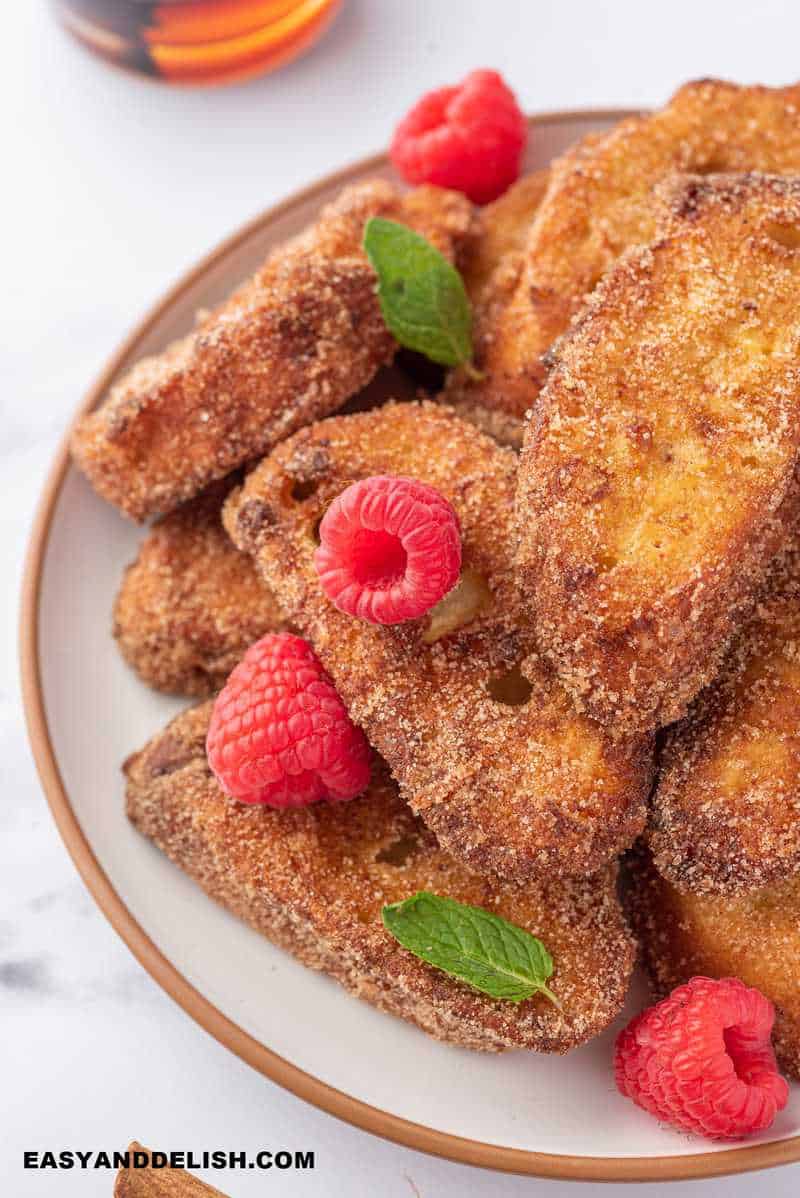
I can still remember watching my maternal Grandma, Socorro, standing at her stove as she prepared this treat. The aroma coming from her kitchen still fills my mind with delish memories.
As an adult, I treasure all of the moments that I spent as a child in her kitchen and in her company. I would give anything to go back in time and have her hand me a slice of rabanada with that big smile on her face.
Time can be quite ruthless... that is why I have started my own memories, this time with my own children.
From my grandma to me, and from me to my little ones (and hopefully to my grandchildren)...
What I truly want to do is to create fond memories with my loved ones and fill them with all the happy thoughts that will stay with them even when I too have long become a memory.
Merry Christmas!

Table of Contents
- 1 What's Rabanada?
- 2 Variations
- 3 Ingredients and Substitutions
- 4 Rabanada vs. French Toast
- 5 Brazilian or Portuguese Rabanadas vs. Rebanadas de Mantequilla
- 6 How to Make Rabanadas (Traditional Method: Deep Fried French Toast)
- 7 How to Make Rabanadas in the Oven (Alternative Method)
- 8 How to Serve Rabanadas
- 9 Can I make this Rabanada Recipe ahead of time?
- 10 How long are its leftovers good for?
- 11 Can I freeze this Brazilian French toast?
- 12 Other Holiday Desserts:
- 13 Rabanadas (Brazilian French Toast)
What's Rabanada?
Rabanada (pronunciation: hah-bah-nah-duh; plural: rabanadas) ) is a type of French toast made with stale French baguette soaked in a mixture of milk, vanilla, and sugar, dipped in beaten eggs, deep-fried, and then coated in sugar-cinnamon.
It dates from the 15th century, as cited by Juan del Encina: '...honey and lots of eggs to make rabanadas...' noted as a dish helpful for recovery from childbirth.
This is why it is also known as fatia parida or fatia-de-parida (i.e. slices for the new mom).
The first recipes trace back to the cookbook of Hernández de Maceras (from 1607) as well as the "Arte de cozina, pastelería, vizcochería y conservería" by Francisco Martínez Motiño (from 1611).
By the beginning of the 20th-century rabanada was a hit in the taverns of Madrid where it was served with jugs of wine. The dish is common during the Lent festival in Spain, while in Portugal it's served at Christmas time.
From Spain to Portugal and then from Portugal to Brazil, which was of course once its main colony.
Variations
You may see some designate this treat as Portuguese French Toast while others, like us, designate it as Brazilian French Toast.
Although the Portuguese and Brazilian prep are almost the same, there are some variations in the ingredients.
The Portuguese rabanada recipe calls for soaking the bread in milk (flavored with spices and/or orange or lemon zest), wine (Minho province uses vinho verde, red or white), or sugar syrup.
On the other hand, Brazilian rabanada has the bread soaked in either plain milk or a mixture usually made from milk, sugar, and vanilla.
There are also differences in the way that they are served. In both countries, they are often served plain.
Yet, in Minho province, they may be drizzled with a wine syrup, while in my home country, they may be drizzled with honey, sugar syrup, or maple syrup (xarope de bordo).
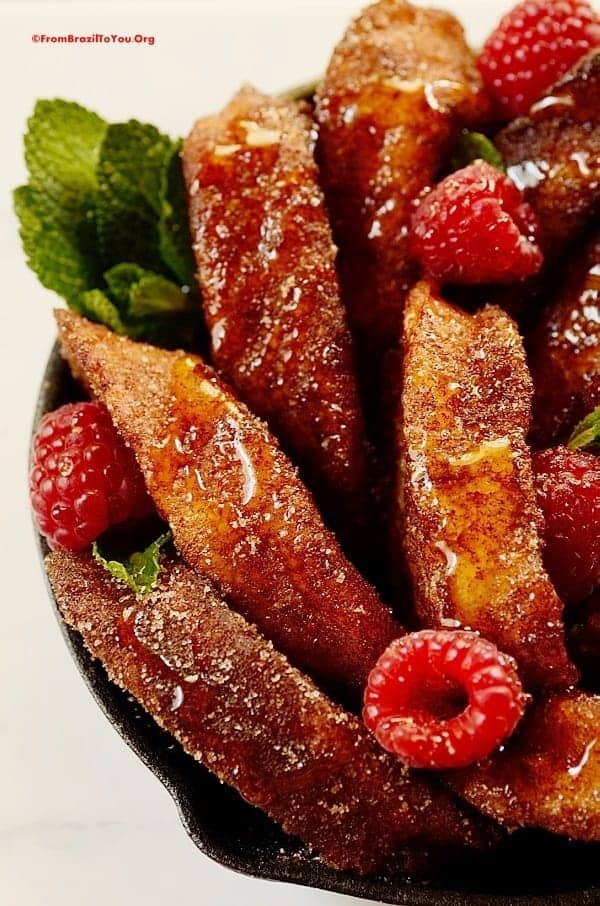
Ingredients and Substitutions
This is one of those great pantry recipes because most ingredients are low-cost and found in most pantries.
- Stale French baguette: Like any other French toast, rabanada calls for stale bread, more specifically a French baguette which is the type of bread traditionally used to prepare the recipe. If the bread is not stale, the toast will be soggy. If you did not have time to leave the bread out overnight in order to dry out, no worries! Just slice the bread, place the slices onto a baking sheet in one single layer, and bake at 375 F (190 C) for about 10 minutes. Let them cool before making the rabanadas.
- Whole milk: if you prefer, you can use half-and-half or even heavy cream for a more custardy French toast. Of course, you can use plant-based milk such as almond milk for making it vegan.
- Vanilla extract: I use pure vanilla extract as the flavoring agent but you can make a variation by using almond extract or orange rind for example.
- Granulated sugar: For a vegan version, use coconut sugar instead.
- Eggs: It will give the French toast a golden color. They are not mixed with milk, vanilla, and sugar as in most French toast custard recipes. Instead, they are used to having the soaked bread dipped into the beaten eggs before frying.
- Vegetable oil for frying: The best type is one with a mild flavor. Avoid Peanut oil among others with a strong flavor.
- Ground cinnamon: It is mixed with sugar and used to cover the French toasts for a final touch – just like with churros.
Rabanada vs. French Toast
Rabanada is different from its cousin, American French toast. How so?
The bread used to make Brazilian French toast has to be stale, usually has either a round or oval shape, and is cut thick.
The way it is prepared is also different! Bread slices are first soaked in milk (or in a milk mixture) and then coated with beaten eggs, fried in oil, and then sprinkled with a sugar-cinnamon mixture.
On the other hand, the American French toast is briefly soaked in a milk-egg mixture and cooked in sizzling melted butter.
The result? The Brazilian French toast is more custardy inside, crunchier outside, and overall sweeter than its American cousin.
Its sweetness may explain why it is served as a dessert or an afternoon snack instead of for breakfast. If you have never tried this, now is your chance!
French baguette or another round/oval bread, milk, sugar, cinnamon, eggs, and oil are available pretty much in any corner of the world.
Brazilian or Portuguese Rabanadas vs. Rebanadas de Mantequilla
Although rabanadas and rebanadas sound similar, they are two different treats.
Rabandas (spelled with "A") is a type of fried French toast popular both in Brazil and Portugal.
On the other hand, rebanadas (spelled with "E") is a Mexican sweet bread usually served sliced with a good spread of butter on top.
How to Make Rabanadas (Traditional Method: Deep Fried French Toast)
- Line a large baking sheet with a double layer of paper towel. Set aside. Divide bread slices between 2 large, shallow baking dishes, arranging them in one single layer each. In a jar or pitcher, mix well the milk, vanilla, and sugar.
- Pour the milk mixture over the bread slices, distributing the liquid evenly over all the slices. Let bread slices soak for about 20 minutes, allowing them to soak up as much of the milk mixture as possible.
- By hand, pick up each one of the milk-soaked bread slices (handling it gently) and dip it into the beaten eggs, coating both sides and allowing the excess to drip back into the egg bowl.
- In a large heavy skillet, heat about 2 inches of vegetable oil over medium-high until oil is hot enough that it sizzles. Place the bread into the hot oil, and deep-fry until well-browned on one side, about 1 to 1-½ minutes.
- Flip the bread and cook until both sides are golden brown. Transfer rabanadas to the sheet lined with paper towels. Repeat with remaining slices of bread, cooking several simultaneously if the skillet is large enough. NOTE: Cook in batches and do not overcrowd the pan! You may have to lower the heat a bit for the next batches or cook slices in less time since the temp will be higher.
- In a medium bowl, mix sugar and cinnamon together. Dredge all sides of the bread slices into the mixture. Any excess cooked egg threads can be removed before dredging bread slices into a sugar-cinnamon mixture.
- Brazilian French toast can be served either warm or at room temperature, by itself or drizzled with honey or maple syrup. I garnished mine with berries. In Brazil, it is served as a Christmas dessert or an afternoon snack, but it can be enjoyed any time of the year!
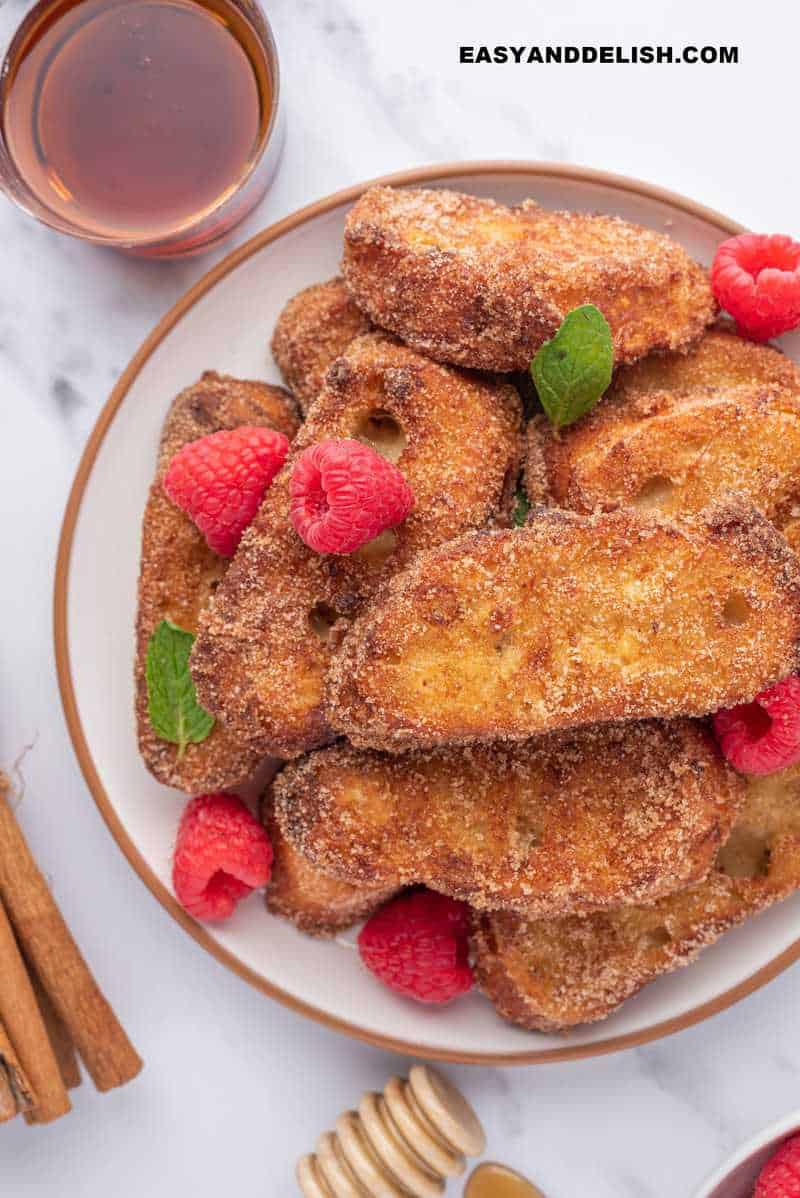
How to Make Rabanadas in the Oven (Alternative Method)
- Follow steps 1 to 3 as directed in the recipe. Then place the bread slices on a baking sheet lined with parchment paper.
- Bake at 350 degrees F (180 degrees C), for 10 to 15 minutes per side. If you leave it in the oven for longer it will dry out!
- Roll in the cinnamon-sugar mixture and serve while it is hot!
How to Serve Rabanadas
In my home country Brazil, rabanada is not a breakfast and brunch dish. We serve it as a dessert or an afternoon snack, along with coffee.
But if you prefer, you can serve it as-is or top it with honey or maple syrup (more for breakfast) or even whipped cream and fresh berries (as like a dessert). Another way it is to eat topped with vanilla ice cream!
Can I make this Rabanada Recipe ahead of time?
Freshly made is the best way to enjoy rabanada. But if you prefer, you can also make it one day ahead and store in an airtight container in the fridge.
Serve at room temperature or warm them in a preheated oven at 350 degrees F for around 6-8 minutes or until hot. Avoid microwaving them because they may be too soft at first and then hardened too much as it cools down.

How long are its leftovers good for?
A day or two, chilled in the fridge.
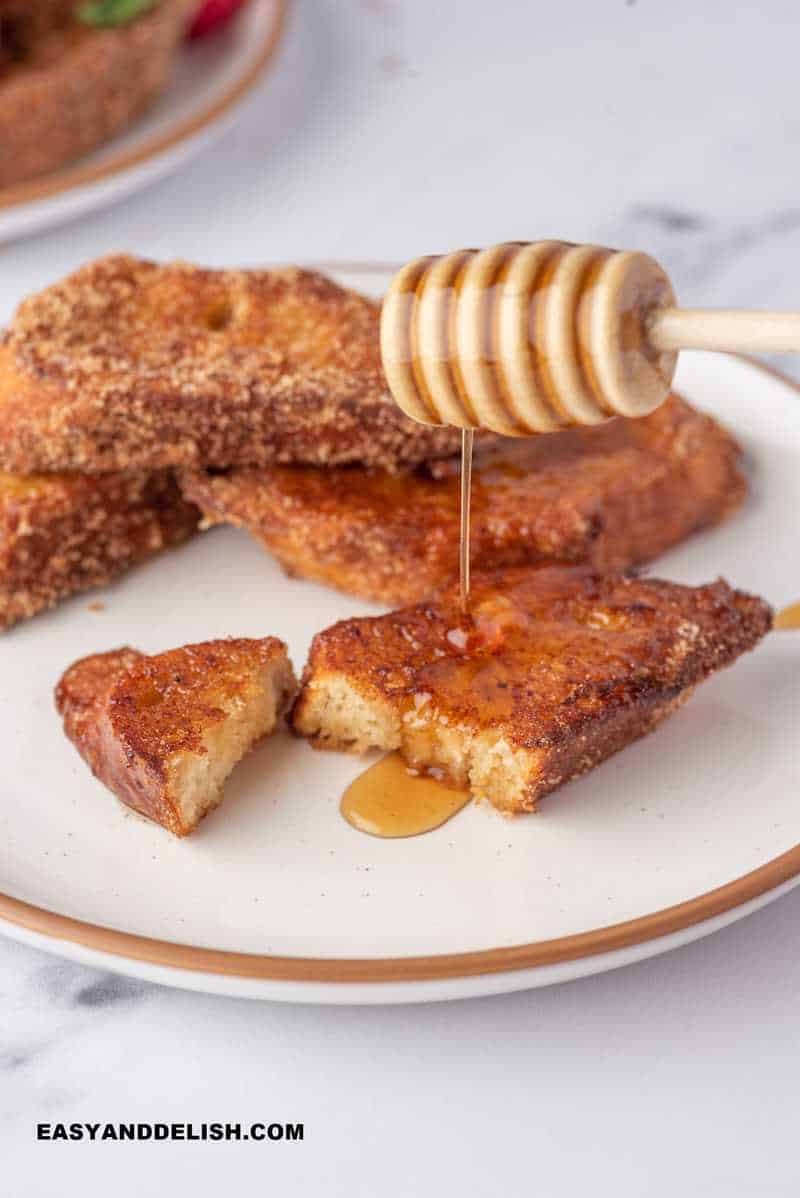
Can I freeze this Brazilian French toast?
Yes! Although I prefer to make and enjoy fresh.
All that you have to do to store rabanadas in the freezer is to cook them according to the recipe (but do not cover them in the sugar-cinnamon mixture) and let them cool completely. Then, place them onto a baking sheet lined with parchment paper in a single layer, cover tightly with plastic wrap, and let them freeze (about 2-4 hours).
Next, transfer them to a freezer bag, squeeze out as much air as possible, and store them in the freezer for up to 2 months, until ready to eat. As you can see it is one of those easy freezer recipes.
Reheat frozen French toasts in the oven at 350 degrees F, covered with foil, for about 10 minutes or until hot. Then, cover them in the sugar-cinnamon mixture.
Other Holiday Desserts:
- Pão de Mel
- Coconut Sugar Cookies
- Dulce de Leche Cinnamon Cookies
- Quick Panettone
- How to make French toast (2 ways)
PIN & ENJOY!
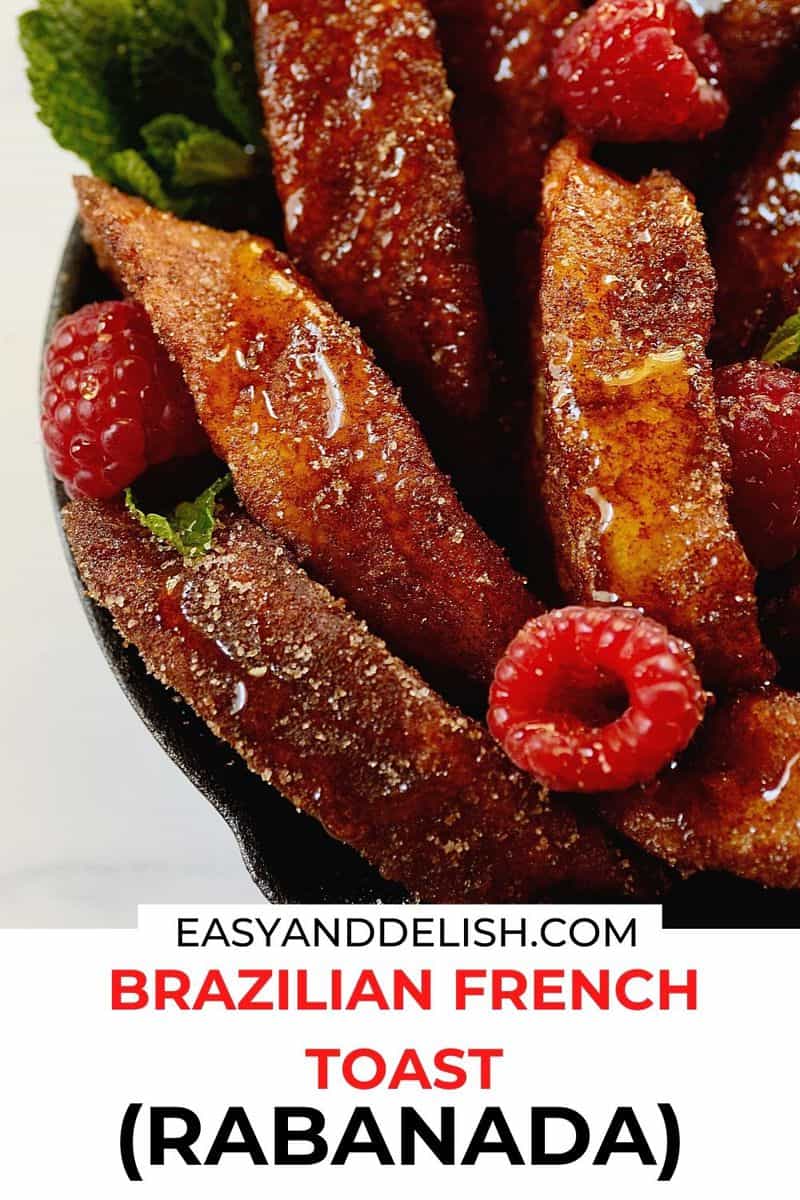
Rabanadas (Brazilian French Toast)
Equipment
- frying pan
- bowls
Ingredients
- 24 slices stale French baguette ¾-inch thick (about 1-½ baguettes)
- 2 cups whole milk
- 1 tablespoons pure vanilla extract
- ½ to ¾ cup granulated sugar
- 4 large eggs lightly beaten and homogeneous
- Vegetable oil for frying
- ½ cup sugar
- 1 tablespoons ground cinnamon
- Honey or maple syrup to serve with optional
Instructions
- Line a large baking sheet with a double layer of paper towel. Set aside. Divide bread slices between 2 large, shallow baking dishes, arranging them in one single layer each. In a jar or pitcher, mix well the milk, vanilla, and sugar.
- Pour milk mixture over the bread slices, distributing the liquid evenly over all the slices. Let bread slices soak for about 20 minutes, allowing it to soak up as much of the milk mixture as possible.
- By hand, pick up each one of the milk-soaked bread slices (handling it gently) and dip it into the beaten eggs, coating both sides and allowing the excess to drip back into the egg bowl.
- In a large heavy skillet, heat about 2 inches of vegetable oil over medium-high until oil is hot enough that it sizzles. Place the bread into the hot oil, and cook until well-browned on one side, about 1 to 1-½ minutes.
- Flip the bread and cook until both sides are golden brown. Carefully transfer rabanadas to the sheet lined with paper towels. Repeat with remaining slices of bread, cooking several simultaneously if the skillet is large enough. NOTE: Cook in batches and do not overcrowd the pan! You may have to lower the heat a bit for the next batches or cook slices in less time since temperature will be higher.
- In a medium bowl, mix sugar and cinnamon together. Dredge all sides of the bread slices into the mixture. Any excess cooked egg threads can be removed before dredging bread slices into the sugar cinnamon mixture.
- Brazilian French toast can be served either warm or at room temperature, by itself or drizzled with honey or maple syrup. I garnished mine with berries. In Brazil, it is served as a Christmas dessert or an afternoon snack, but it can be enjoyed any time of the year!
Recipe Video

Recipe Notes
- STORAGE: Rabanada is best when enjoyed right away. But you can store leftovers in an airtight container in the fridge for up to 2 days. Or freeze in a freezer bag (without the sugar-cinnamon mixture) in one single layer for up to 2 months.
- FOR A GLUTEN-FREE VERSION, use a GF bread!
- Follow steps 1 to 3 as directed in the recipe. Then place the bread slices on a baking sheet lined with parchment paper.
- Bake at 350 degrees F (180 degrees C), for 10 to 15 minutes per side. If you leave it in the oven for longer it will dry out!
- Roll in the cinnamon-sugar mixture and serve while it is hot!
Nutrition
** Nutrition labels on easyanddelish.com are for educational purposes only. This info is provided as a courtesy and is only an estimate, since the nutrition content of recipes can vary based on ingredient brand or source, portion sizes, recipe changes/variations, and other factors. We suggest making your own calculations using your preferred calculator, based on which ingredients you use, or consulting with a registered dietitian to determine nutritional values more precisely.
Please note that health-focused and diet information provided on easyanddelish.com is for educational purposes and does not constitute medical advice, nor is it intended to diagnose, treat, cure, or prevent disease. Consult with your doctor or other qualified health professional prior to initiating any significant change in your diet or exercise regimen, or for any other issue necessitating medical advice.
Post first published on 12/07/2015.




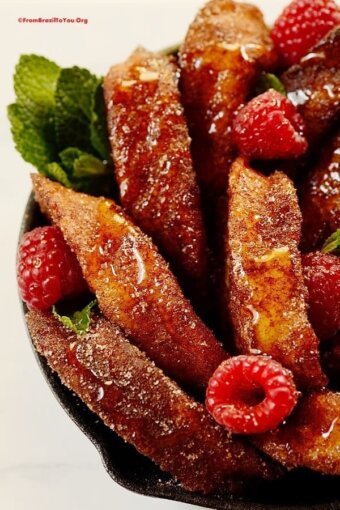
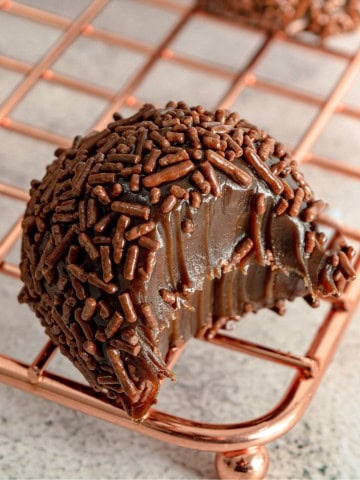


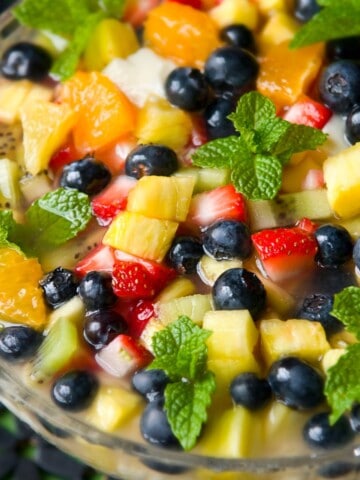
Mardith says
To bake it, you say, follow Steps 1 - 4, but isn't it steps 1-2? I assume baking it reduces fat content. Mardi
Denise Browning says
Hi Mardi! Yes, the baking process reduces the fat content of the recipe and also decreases the number of calories.
I have just corrected the recipe and also included the baked version in the recipe card notes. I apologize for the inconvenience that it may cause you. Thank you!
Mardi says
Thank you, Denise. How kind of you! Mardi
Denise Browning says
My pleasure! Thank you for calling out that mistake. I really appreciate it!
Dennis Yannakos says
This look is just...irresistible! My mouth is water!
Kitchen Utensils Review
Josaih - DIY Thrill says
This Brazilian French toast looks so good, I need to try this recipe!
Denise Browning says
Thank you! Rabanadas are one of the most popular Christmas desserts in Brazil.
John / Kitchen Riffs says
Really, really nice. 🙂 Thanks. And happy holidays!
Logan says
Thanks for the family recipe. I lived in a Rio for a couple years, 16 years ago and I've been missing rabanada. Your recipe popped right up and I look forward to trying it. Regarding the above mentioned wine modification (in Portuguese) could I just dip the milk soaked bread into a 1:1 ratio cooking red wine : water, then dunk in egg and fry? Muito obrigado!!!
Denise Browning says
Hi, Logan!!! Absolutely!! You can replace the vanilla-flavored milk for a good red or white cooking wine. Either one will give flavor to the French toast in the soaking process. Then you dunk the soaked bread in eggs and fry according to the recipe instructions. I don't recommend the use of water for the soaking process because it won't flavor the bread. I hope this helps. Enjoy!!!
Little Cooking Tips says
What a sweet post...!:) Both due to the recipe as well as the memories! After all, why do we do this? Why blog if we can't share some memories, some experiences with others. It's what make the recipes unique to each and every one of us, right? We wish you will share this exact recipe with your grandchildren one day Denise! We know they'll cherish both the recipe and their grandma:)
Thank you for the delicious treat, the cultural context and the memories!
MERRY CHRISTMAS DENISE! May the new year bring joy, health and happiness to you and your family!
Lots of hugs from both of us!
xoxoxo
Hadia says
Such a wonderful recipe, Denise. My son is coming back home frome college. I will definitely surprise him on Christmas with your awesome Rabanada. There is nothing better than sharing foods and memories of grandmas. Wish you and your family a merry Christmas and a very happy new year! Xo Xo...Hadia
Denise Browning says
Hadia, thank you! I hope he enjoys as much as my family and I do. Merry Christmas and a marvelous 2016 for you and your family.
Asha says
This is an amazing recipe for Christmas morning. The kids and adults would love love this.
I love the custardy toast. Pinning for sure to make it sometime.
xoxo
All That I'm Eating says
This sounds absolutely delicious, what a nice twist on a classic.
Amira says
What an interesting recipe, I bet kids and adults will be thrilled to try this delicious toasts. I have a feeling that it will be super hard to pick up the toast pieces and dipping them in the egg... any tips on that?... Sharing this on FB this now:)
Denise Browning says
Thanks so much for sharing it, Amira!
John/Kitchen Riffs says
Wow! This looks great. Love French toast, and this looks much better. Gotta try it! Thanks.
Jasline (Foodie Baker) says
Oooh I love the fact that it's more custard-y! I always soak my french toast for a loooong time before pan-frying it so that the inside is really custard-y. I definitely have to give yours a try!
marcela says
oh wow! sounds great! My Brazilian friends are gonna love it!
Deb|EastofEdenCooking says
Fantastic Denise! I always sprinkle cinnamon on my French Toast! I can just imagine all the sweets memories you are making with your daughters!
Cristina says
Minha mae sempre faz rabanada na epoca do natal... ela sempre usa vinho e fica uma delicia! Um pouquinho diferente da tua receita... mergulha o pao no vinho com agua, depois na na outra mixtura. Fica uma maravilha coberto com acucar e canela!
Mas muito obrigada por postar essa outra versao q eu nao conhecia.
Feliz Natal!!!
Denise Browning says
Cristina: Que surpresa boa ver uma brasileira aqui. Com vinho deve ficar uma delícia também. A minha avô materna era de decendência portuguesa e sempre fazia a dela embebida no leite -- é muito comum em Pernambuco também. Essa minha receita é bem parecida com a dela. A única diferença é que eu misturo um pouco de açúcar e essência de baunilha com o leite para dar um gosto melhor. O pão amanhecido suga essa mistura de leite e dentro fica bem molhadinho e gostoso. A minha avô servia sem mel por cima mas aqui na minha casa adoramos das duas maneiras. Espero que você possa experimentar! Vale a pena. As minha filhas gostaram tanto que já pediram pra eu fazer de novo. Um abraço!
Mi Vida en un Dulce says
Well, December is the time for food, I never eat as much as I do in this time of the year. And here in the south side of the world is not the best thing to do because it's beach season 🙂
Amy says
Oh, I like this, we just got a new recipe for breakfast.
Denise Browning says
Thanks, Amy! Although this a traditional Christmas dish from my home country, I made it for the first time for my 9-and-7- year-old children and they loved it. They have already requested it several times so I will be making for Christmas day again. I hope your family and you enjoy this treat. Thanks for stopping by!
Raymund says
Now I dig it, looks like I need to visit Brazil soon because of all of these amazing sweet dishes, you guys know how to please people with sweet tooth, just look at that beauty of a French Toast
Denise Browning says
Thanks, Raymund! Yep, we got a very sweet tooth. 🙂 Merry Christmas to you and your family!